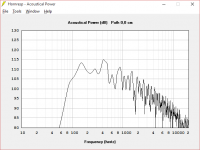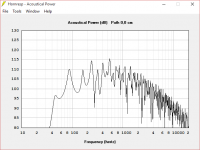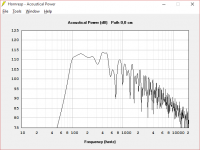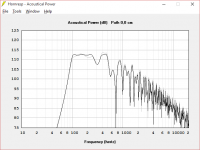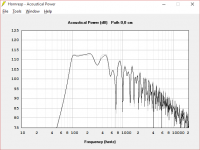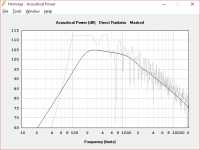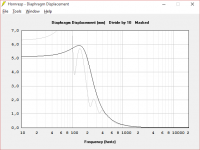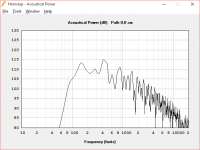I have been trying to write an answer to you GM, but keep getting distracted. Sorry.
I call it an AV receiver, but I mostly bought it for its (music) streaming capabilities. No IMAX SPLs in this households. You can pretty much still converse when music is on of when we are watching a movie, though talking a bit louder than normal. My first priority is easily getting the line arrays some enclosures that extend their range in a way that matches their midrange energy/dynamics. A BiB sub is definitely a possibility after that.
I have six units of the Visaton FRS5X drivers per side, mounted (glued) to baffle boards. The idea being that I could fix the drivers well by permanent glueing (not much meat on the flange for mounting) and still try out different types of enclosures. So far on open baffles, wonderfully dynamic sound, much more so than a single unit in a sealed box, but still that very fine small fullrange driver sound. Also better (narrower) vertical dispersion characteristic for my somewhat reverberant room.
With the sealed boxes with a single driver, and baffle step, response doesn't reach deep enough for a good crossover to a sub at 250Hz or preferable lower. Total cone area of the line array is 6x12.5cm^2 = 75 cm^2, about midway between Fostex FE126EN and Markaudio Alpair 10.
For a sub, I have an available corner. For the main speakers, I can only place them against the back wall at the moment. Shame, because corner placement would make it ~ideal stereo triangle. If I get the crossover between mains and sub down somewhat, the sub could move to a less visible location and that would also allow more pipe length.
Fs 190Hz, Qts 0.7, Vas 0.23 liter. Two groups in series, each group three in parallel (but easily changed if advisable). Xmax is not given, a German reviewer suggested it's high(er) excursion version of Visaton FRS5, which has Xmax +/- 2mm. So maybe safe to assume it's about +/- 2mm and be happy if it turns out more.
Vb = 20xVasxQts^1.25 = 20x(6x0.23)x(0.7^1.25) = 17,67 liter
I'm kind of stuck on choosing line length/tuning. Obviously, Fs being 190Hz, I could go for 190 Hz tuning, half wave length leading to about 91 cm tall unfolded. Depth of the pipe would be an issue, as would driver height. Not really much range extension. If I use Fs*Qts/2 I get 66.5Hz. That indicates lowest "hornloadable" frequency. Does that mean I can input that into the calculator (making half wave length and folded height 129.7 cm and more practical for me), or would that load too low due to half wavelength? I set the crossover on the AV receiver and it probably would never be fed signal that low (except for cautious testing as entertainment).
I tried some sims in Hornresp. The results look very different from the Mathcad/MJK sheets sim graphs I see posted in this thread. Some of this is down to scaling of the graphs and I know Hornresp and MJK's sheets differ in their assumptions about losses etc., but they still look pretty different. Hornresp is less pretty. Things improve when increasing box volume dramatically and adding some length (extending the horn in the same expansion) to try to emulate the corner/room extension. Nice graphs, but still not much like the graphs I see here. The reports are positive and these are complex to simulate due to room influences, so I will just build one and see.
But how would you guys, especially GM, go about this one? I read in the thread you used to build pipehorns that were not cornerloaded, with bigger volume. Any advice for this build? I live in a fully concrete and brick house, by the way.
I am leaning towards the 66.5 Hz, half wavelength, folded, inverted BiB, with the bottom cut off at a 45 degree angle and otherwise placed on the floor. I guess I can use the calculator, but considering 1/4 loading instead of 1/8, should I increase Vas in the calculator? Is there a convenient fudge factor? What are your ideas about line length, practical limits regarding driver specs etc,
I call it an AV receiver, but I mostly bought it for its (music) streaming capabilities. No IMAX SPLs in this households. You can pretty much still converse when music is on of when we are watching a movie, though talking a bit louder than normal. My first priority is easily getting the line arrays some enclosures that extend their range in a way that matches their midrange energy/dynamics. A BiB sub is definitely a possibility after that.
I have six units of the Visaton FRS5X drivers per side, mounted (glued) to baffle boards. The idea being that I could fix the drivers well by permanent glueing (not much meat on the flange for mounting) and still try out different types of enclosures. So far on open baffles, wonderfully dynamic sound, much more so than a single unit in a sealed box, but still that very fine small fullrange driver sound. Also better (narrower) vertical dispersion characteristic for my somewhat reverberant room.
With the sealed boxes with a single driver, and baffle step, response doesn't reach deep enough for a good crossover to a sub at 250Hz or preferable lower. Total cone area of the line array is 6x12.5cm^2 = 75 cm^2, about midway between Fostex FE126EN and Markaudio Alpair 10.
For a sub, I have an available corner. For the main speakers, I can only place them against the back wall at the moment. Shame, because corner placement would make it ~ideal stereo triangle. If I get the crossover between mains and sub down somewhat, the sub could move to a less visible location and that would also allow more pipe length.
Fs 190Hz, Qts 0.7, Vas 0.23 liter. Two groups in series, each group three in parallel (but easily changed if advisable). Xmax is not given, a German reviewer suggested it's high(er) excursion version of Visaton FRS5, which has Xmax +/- 2mm. So maybe safe to assume it's about +/- 2mm and be happy if it turns out more.
Vb = 20xVasxQts^1.25 = 20x(6x0.23)x(0.7^1.25) = 17,67 liter
I'm kind of stuck on choosing line length/tuning. Obviously, Fs being 190Hz, I could go for 190 Hz tuning, half wave length leading to about 91 cm tall unfolded. Depth of the pipe would be an issue, as would driver height. Not really much range extension. If I use Fs*Qts/2 I get 66.5Hz. That indicates lowest "hornloadable" frequency. Does that mean I can input that into the calculator (making half wave length and folded height 129.7 cm and more practical for me), or would that load too low due to half wavelength? I set the crossover on the AV receiver and it probably would never be fed signal that low (except for cautious testing as entertainment).
I tried some sims in Hornresp. The results look very different from the Mathcad/MJK sheets sim graphs I see posted in this thread. Some of this is down to scaling of the graphs and I know Hornresp and MJK's sheets differ in their assumptions about losses etc., but they still look pretty different. Hornresp is less pretty. Things improve when increasing box volume dramatically and adding some length (extending the horn in the same expansion) to try to emulate the corner/room extension. Nice graphs, but still not much like the graphs I see here. The reports are positive and these are complex to simulate due to room influences, so I will just build one and see.
But how would you guys, especially GM, go about this one? I read in the thread you used to build pipehorns that were not cornerloaded, with bigger volume. Any advice for this build? I live in a fully concrete and brick house, by the way.
I am leaning towards the 66.5 Hz, half wavelength, folded, inverted BiB, with the bottom cut off at a 45 degree angle and otherwise placed on the floor. I guess I can use the calculator, but considering 1/4 loading instead of 1/8, should I increase Vas in the calculator? Is there a convenient fudge factor? What are your ideas about line length, practical limits regarding driver specs etc,
I am leaning towards the 66.5 Hz, half wavelength, folded, inverted BiB, with the bottom cut off at a 45 degree angle and otherwise placed on the floor. I guess I can use the calculator, but considering 1/4 loading instead of 1/8, should I increase Vas in the calculator? Is there a convenient fudge factor? What are your ideas about line length, practical limits regarding driver specs etc,
Additional clarification: the intention is never to run the line array BiB fullrange, rather to create enough range and efficiency to smoothly crossover to the woofer section. The lower the better, but in this case reaching well to 250 Hz is already a great success and reaching perhaps below 200 Hz or even to 100 Hz would be a great success.
I could follow GM's suggestion of limiting sub-BiB use to two octaves. My intended sub-BiB driver is the Eminence Kappa 12, Fs 45 Hz. With ~75% ceiling height as BiB height, it would be about 40 Hz half wavelength (folded upright) and then 40x2x2= ~160 Hz. So perhaps a good goal for crossing over?
Can the woofer be moved down?
Yes, though ideally at its odd harmonics, which acoustically varies along its length depending its taper and how much the local boundaries are extending it, so while it can be calculated close enough by MJK or similar, there's no simple ROT, ergo either use his software for close enough accuracy or at least Hornresp to get in the 'ballpark' with the understanding that as the driver moves down it will reduce pipe/horn loading and up to a point of diminishing returns above its 3rd harmonic it will smooth out its response.
GM
But how would you guys, especially GM, go about this one?
Assuming I followed all this, you ideally need it to be a three way system with the sub tuned to at, or below, its 3rd harmonic, with a mid-bass/lower mids stereo pair of arrays to keep the sonic signature fairly close and due to the acoustic power structure of orchestra or similar wide BW music, the HF array ideally needs to be XO'd > 300 Hz, and preferably 400-500 Hz in your app to keep excursion to just fractions of a mm in a low peak SPL, wide BW HIFI app where ANY distortion tends to stand out like a 'sore thumb', especially to any females not rendered tone deaf from earphone/whatever sonic abuse.
More to come as time permits………….
GM
Assuming I followed all this,
Haha, yeah, I wrote quite a lot, didn't I? 🙂 Haven't built for years, but kept thinking about it. All the thoughts came out in one go.
Let's stick to the HF arrays for now, my priority for now.
Highest crossover on the AV receiver is 250 Hz. As higher than 300 Hz is preferable, lower than 250 Hz is certainly not desirable, so there we are. I have been simming lots in hornresp. I get better linearity with double Vb, but low end response seems quite a lot louder than driver/array response. Perhaps this disappears in baffle step, but I'm not sure. I will post some screenshots.
OK.
Using manufacturer's specification, Fs 190, Qts 0,7, Vas 0,23 liter. I am using six drivers per array.
Tuning frequency 133 Hz
Line Length 50,62" or 128,57cm
Zdriver 10,98" or 27,9cm
Sm – Terminus Area (sq. in.) 42,61"^2 274,90 cm^2
Tuning frequency 66,5 Hz
Line Length 101,24" 257,14cm
Zdriver 21,97" 55,80cm
Sm – Terminus Area (sq. in.) 21,30"^2 137,45cm^2
Using manufacturer's specification, Fs 190, Qts 0,7, Vas 0,23 liter. I am using six drivers per array.
Tuning frequency 133 Hz
Line Length 50,62" or 128,57cm
Zdriver 10,98" or 27,9cm
Sm – Terminus Area (sq. in.) 42,61"^2 274,90 cm^2
Tuning frequency 66,5 Hz
Line Length 101,24" 257,14cm
Zdriver 21,97" 55,80cm
Sm – Terminus Area (sq. in.) 21,30"^2 137,45cm^2
Attachments
OK, some spare time. 133 Hz puts the center of the short array at ear height and it also seems to be a decent tuning frequency for this array. Fighting my urges to simulate further ENDLESSLY, I will just leave it at that. 😀
Bigger is better, so incremental simulations of 1xVas, 2x, 3x and 4x. 3x looks best. I added comparisons of the 3xVas BiB and the array in a sealed box, both frequency response and excursion.
Bigger is better, so incremental simulations of 1xVas, 2x, 3x and 4x. 3x looks best. I added comparisons of the 3xVas BiB and the array in a sealed box, both frequency response and excursion.
Attachments
DIMS – Internals In Cm
Line Length 50,62 128,57
Zdriver 10,98 27,90
Sm – Terminus Area (sq. in.) 127,83 824,69
Wood thickness 0,71 1,80
Baffle thickness 0,71 1,80
Line Length 50,62 128,57
Zdriver 10,98 27,90
Sm – Terminus Area (sq. in.) 127,83 824,69
Wood thickness 0,71 1,80
Baffle thickness 0,71 1,80
Perhaps this disappears in baffle step, but I'm not sure. I will post some screenshots.
Yes, up to 6 dB of the low end unless up against a rigid/massive enough wall to reflect the BW's acoustic output.
GM
I added comparisons of the 3xVas BiB and the array in a sealed box, both frequency response and excursion.
Yeah, big gains. FWIW, if I ever get to build again, one of the things I want to try is adding a secondary driver to 'tap' into BIB to fill in its large 3rd harmonic dip. Easy enough to figure out, especially now with Hornresp's capability, but not sure how much it will 'color' the main driver's output even if its HF output is steep order digitally XO'd.
GM
Last edited:
Slant
Hello !
I have a question about the slant. Is what we should ignore its thickness? I noticed that on the bib calculator, changing the thickness of the wood does not change the internal dimensions. If we take the thick woods, it distorts the internal dimensions and internal volume.
Hello !
I have a question about the slant. Is what we should ignore its thickness? I noticed that on the bib calculator, changing the thickness of the wood does not change the internal dimensions. If we take the thick woods, it distorts the internal dimensions and internal volume.
Greets!
The divider, driver and some bracing [+ some for tuning flexibility with stuffing] is already accounted for in the formula.
GM
The divider, driver and some bracing [+ some for tuning flexibility with stuffing] is already accounted for in the formula.
GM
I had some old fir panels and looked how close I could get to my preferred alignment. Turned it had to be bit smaller, but simulated response is almost alike, except for a single pixel here and there. Close enough. I already cut the boards, in the sunshine. Can't wait to glue and have a listen!
I had some old fir panels and looked how close I could get to my preferred alignment. Turned it had to be bit smaller, but simulated response is almost alike, except for a single pixel here and there.
The design is very forgiving. You will be very pleased with the results. Just make sure there are no air leaks and it will work like a charm.
Glue is drying, very exciting! It's not as big as some stuff I've built, but in relation to driver size it's huge. I have a hard time imagining the sound. Will report back!
Yeah, folks would look at me like I was nuts when they'd see ~5"- 8" mobile audio drivers in up to ~10 ft^3 cabs until I cranked them up for a little 'headbanger's ball' R&R, that is  😀
😀
GM
 😀
😀GM
Get them into corners and enjoy!
You may have to tune the bass with stuffing.
https://speakerprojects.wordpress.com/cabinet-types/bib-loudspeakers/bib-calculator/
You may have to tune the bass with stuffing.
https://speakerprojects.wordpress.com/cabinet-types/bib-loudspeakers/bib-calculator/
Quick question for 'Zilla - what's the difference between the v1 and v2 spreadsheets and which would you prefer us to host on Ted's site?
- Home
- Loudspeakers
- Full Range
- Terry Cain's BIB -why does it work and does anyone have those Fostex Craft Handbooks?
